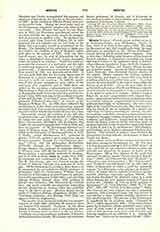

Müntz, Eugene. French savant and historian; b. at Soulz-sous-Forets, near Mülhausen, Alsace, June 11, 1845; d. at Paris, November 2, 1902. He took up the study of law, but turned aside from the legal profession to contribute to the “Revue Alsacienne” certain articles which caused much comment. Just at that time following upon the great efflorescence of learned criticism in Germany attention was being directed in France to the organized study of history. Albert Dumont founded at Rome the Ecole Francaise, in the Farnese Palace, and Eugene Müntz became one of its first pupils. Among his fellow-students was Louis Duchesne, who afterwards became director of the school. Müntz explored the Vatican Archives and Library, and began to amass that vast fund of erudition which he revealed in later years. From that time he devoted himself to the task of unravelling the history of art in Italy. About the year 1880, he, together with such men as Morelli and Milanesi, contributed immensely to this branch of study, and applied to it the positive method of inquiry. Müntzs work is based on an exact acquaintance with original documents papers preserved in archives, memoranda, bills, inventories, contracts—supported by an extensive and profound knowledge of monuments. He never loses sight of the bond between the arts, that close relation-ship by which all the art industries of a period its engraving, its tapestry weaving, its pottery, its cabinet making contribute, as so many expressions of contemporary thought, to form the genius of its painters, sculptors, and architects. Captivated by that Rome where the fairest years of his life had been spent in studious research, he never ceased to regard the Rome of Julius II and Leo X, of Bramante, Michelangelo, and Raphael, as the highest expression of human civilization. This attitude of mind at times hindered his doing justice to other schools—for instance, to those of Venice and Siena.
The earliest works of Müntz at once won for him a high place among the historians of art. In “Les Arts a la tour des papes pendant le xve et XVIe siecles” (4 vols., 1875-98) he has collected evidence to show the splendid part played by the papacy as leader of the Renaissance. When two volumes of this work had appeared, its author issued “Precurseurs de la Renaissance” (1881), and followed this with “Raphael“, to which it is a sort of introduction. The “Precurseurs” and “Raphael” are still classics (Ist ed. 1881; 2nd ed. 1886); to them must be added a small but important volume “Les Historiens et les critiques de Raphael” (1884), in which Müntz defends traditional against modern criticism, especially against Morelli. He afterwards developed his cherished ideas in a work which became the most popular manual in France on Italian art, “Histoire de l’art en Italie pendant la Renaissance” (I, “Les Primitifs”, 1888; II, “L’Age d’Or”, 1891; III, “La Fin de la Renaissance“, 1895). His views are not very original, his taste is somewhat academic, with a bourgeois tinge; but this history is nevertheless a most valuable popular treatment of that glorious period. His picture of the Renaissance is completed by an excellent study, “Leonard de Vinci”, which appeared in 1898. These books form a group by themselves; Müntz published many others, some of them works of sheer erudite research, but most of them bearing on the main work of his life, and forming supplements or additions to it. Among the former are: “Notes sur les mosaiques d’Italie” (1874-91); “Etudes sur l’histoire de la peinture et de l’iconographie chretiennes” (1882); “Etudes iconographiques et archeologiques sur le Moyen Age” (1888). Among the latter we may mention: “Donatello” (1885); “Le Palais des papes a Avignon” (1886-92); “La Bibliotheque du Vatican au xvie siecle” (written in collaboration with P. Fabre 1887); “Collections des Medicis an xve siecle” (1887); “Antiquites de Rome au xive, xve, et xvie siecles” (1887); “Florence et la Toscane” (1897); “La Tiare Pontificale du viiie siecle au xvie siecle” (1897). In a third series of works he took up the study of the influence of the Italian Renaissance in other European countries, especially France: “La Renaissance en Italie et en France a l’epoque de Charles VIII” (1885); “Le Chateau de Fontainebleau an xvie siecle” (1886), in which he collaborated with Molinier. He contemplated extending these studies to the whole of Europe when death interrupted them.
In Müntz’s writings we should look in vain for a personal view, or for any such system or philosophy as gives a work a loftier scope than the merely historical. His cannot compare with the great histories of the Renaissance given us by Taine, Burckhardt, or John Addington Symonds. Still it is a treasury of information. It presents in an easy agreeable form a resume of what research has discovered and criticism accepted. The complete edition of this History was the first model for that class of de luxe books which, thanks to modern processes of reproduction, have done so much in the last thirty years to spread information on art and to improve the public taste. After 1878 Müntz was connected with the Ecole des Beaux-Arts, where he took Taine’s place in the chair of aesthetics from 1885 to 1892. He entered the Institute in 1893.
LOUIS GILLET

